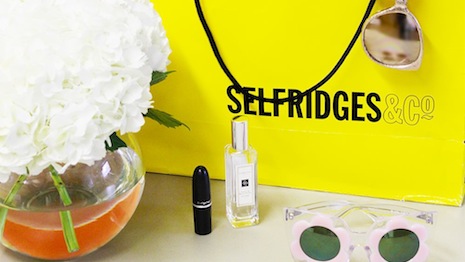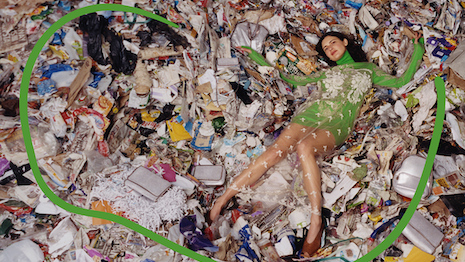As luxury companies strive to be more sustainable, a key part of their efforts should revolve around consumer education, according to a report from Fashionbi.
The last stages in a product’s lifecycle are often among the most wasteful, since consumers today purchase more clothing than before and more frequently discard garments. Per Fashionbi's "Sustainability In The Fashion Industry" report, brands can play a role in shifting consumption patterns through awareness initiatives and a focus on creating better quality, longer lasting fashion.
"Right now, fashion is the second most polluting industry on the planet, only behind oil," said Yana Bushmeleva, chief operating officer at Fashionbi, Milan.
"The textile industry emits more greenhouse gas emissions than international shipping and aviation combined," she said. "And the amount of waste the industry generates, as well as how much water and resources it uses, is increasing.
"Production of clothing has been increasing rapidly, which has led to a decline in utilization per item, or the number of times an item is used before it is discarded. The average person now buys 60 percent more items of clothing every year and keeps them for about half as long as they did 15 years ago.
"Most of this ends up in landfills, where they sit for 200 years leaving toxic chemicals and dyes to contaminate local soil and groundwater. This, combined with a very low rate of recycling, has increased the consumption of resources."
Greener goals
Today, sustainability is a universally acknowledged goal in the luxury business. One of the key areas of focus for greener production is fashion due to its high impact on the environment.
Recognizing the need for more sustainable approaches, a number of companies have worked to reduce their environmental and social impact.
Some have focused on combatting climate change through initiatives such as reducing gas emissions or water use. Others have looked to be more energy efficient or have switched to renewable energy sources, such as Ferragamo’s use of solar power or Prada’s switch to LED lighting.
Packaging has been given a more eco-friendly design, with some brands making their boxes or bags out of 75 percent post consumer recycled materials. For instance, Selfridges uses paper from its coffee cups to make its shopping bags (see story), while Shiseido uses recycled PET resin for its containers.

Selfridges' iconic yellow shopping tote. Image credit: Selfridges
Brands are looking to be more responsible in the sourcing of raw materials, getting supplies from trusted sources or using recycled materials such as precious metals. Kering is aiming to be able to trace 100 percent of its raw materials by 2025.
Others are finding ways to reuse scraps, as Hermès does with its petit h collection (see story).
Along with production comes waste, and many companies are looking to better treat waste and water that are byproducts of creating fashion.
The store is also getting a green makeover as labels open boutiques built with eco-friendly materials and energy efficient standards.
A number of fashion brands have launched reforesting efforts. For instance, American Eagle had a promotion that planted a tree for each garment sold.
Beyond environmental awareness, labels have taken an active role in protecting animal welfare. A number of luxury brands have ended the use of fur, while Tiffany & Co. has sought to combat elephant poaching for ivory (see story).

Tiffany & Co hopes to save the elephants in partnership with Conservation International. Image credit: Ami Vitale.
Outside of company actions, governments are also rolling out regulations aimed at making the fashion industry more transparent and sustainable.
The United States Federal Trade Commission requires that garments have a breakdown of materials used. France has prohibited the disposal of unsold merchandise and is also rolling out a voluntary product life tag that can give consumers a better idea of the life expectancy of certain garments.
Meanwhile, in Peru the cotton and alpaca industries have been working to improve worker safety.
Education and awareness
While corporations and governments are combatting climate change and social issues, consumers will play a significant role in moving the fashion industry in an eco-friendly direction.
Education is key. Online retailer Net-A-Porter’s magazine Porter is dedicating its summer issue to raising awareness about issues related to the preservation of the world’s oceans.
Porter has recruited acclaimed photographer Mario Sorrenti along with cover model Anja Rubik to help helm the publication’s Summer Escape issue, which will draw particular focus to the plastic crisis facing the world’s oceans. The combination of fashion advertising, editorial content and activism towards a sustainable theme is at the core of Porter’s latest edition (see story).

Porter's latest issue is dedicated to the oceans. Image credit: Porter
British department store Harrods is working with streetwear label Vetements to draw attention to the issue of overproduction.
The Zurich-based brand has taken over four of Harrods’ windows for an installation that showcases how much fashion is wasted. While potentially a counter-intuitive message for a brand and retailer, the project aims to inspire a more sustainable fashion strategy (see story).
Some are helping consumers avoid dumping more clothing in landfills. Patagonia, for instance, opened pop-ups that allowed consumers to repair or sell merchandise from the brand.
Stella McCartney similarly teamed up with The RealReal to promote the idea of consignment and buying better quality fashion (see story).
“The customers need to be educated,” Fashionbi's Ms. Bushmeleva said. “Many of us still do not know the environmental impact of a single produced T-shirt that we buy.
“The paradox is that when the customers will have an understanding of the issue they may decrease the consumption and the brands are not interested in losing the sales,” she said. “So probably the first step for the brands is to work on the sustainable materials and explain the value of the single item to justify the fair price.”
{"ct":"wiUrzXmc9rmUNiWTQQ\/rYFU2SQX6qObPKAYD7+amPsAKbAfoPe60YXoeY+SIbmSby8r4dq+gUmyTSp0EpT1sUujWWOPmPl99fOnez8TNt8QpYDTeQcyOpC6a7YJUdKIrx8\/0AEjTOhUQ6MCLioAWW+RZOyfVibPObGuHfk41dHY8WbnZagfxgRyWGSD42t3Gs3ZremSEfQLNPBp2h94vrhueMNuLnpsplvbZDj5op2yjAr\/HtZmQUh0DWWYGnvpo7Tj84tFB2oPMjc6vXNImtYojIu\/Se4Kg1mSaNRQE7pzhCSaOeEOVZBBblFfnEpjB7JYhN\/UVp0ZzehCWXkLyDL0YWb17R9LbejEKi1InhW3O++lPQ8NlgwHZB6OspdQisDbagrqkkm7rmFbyfVnhJgmDzrQHBAieqIm7N\/SMdX0c1E+bwAJy\/qad3YV4PJEuPqvyloCD3w4W+Qvr5KxJTbwa0lct62xlnTJqomx0BB\/B2w+zCPRTpD35aW4C3rKi0DVM3rvAZe\/QJgAJlBQ8gph6GaDmaSPTZ8ypTSzqLRozfYPWdSXNGVlfylZ\/ZU9LW3CYSFzxymJqJRr1vkJs3hYyiVaKYGW86yCC32MtCaYXC+8HYHCKpj+Jne0rvgVWIvOYrILmDFbCwzDkdi1BImiWS6iqBtOH7aM5d8wpShoeMDJrYT50BnDOL6XgjSbitdbImRj74b6pVYMK1GPudi3QQ+lbaPzd+GVP0etUoGjxpnl30lG1FOX3ncaIyjq9pvzKHhoq2oKx4w3Dc2KHWx4RA2fuMhLJG3\/MSpGDAAv7+zh7ehAS9qqtnHX03Dg9CVTYWpIaGDnK4VO\/6AN1ocQe\/btyGxBe3+krTSwMoBNlIYEthPIPF5Z\/GdwAO1+lbOhKPMLjzaW7rmxlGuaSMvP+3JCzuSjSNnoO+QY4V8El9tTmQzL2QUDUbyUeZ0nF\/O2YI37GYKJ4bxtUfJP1PU2FwcYXBdL03+w84QpFci3OcAKJPFjd2d80y\/KZzaEQKIEV6YcXUmdCKUP2QHYyL2qFmu7l4jSVnIQq0garGUTuJqLukqAF0UFkrRIg0S2CEl6+OlUFmK\/YfTG28njGdCXp28YiLY1LlusHtG\/C43BuPPAruoxj6SXNERMJon+DAGcuYinIIsM9lm\/m3ok6iXxuqtRRjKQ7DYOWeU+4Z98PN4PVGqtZI0Sy5hRpP3QR+0w7djiilI\/uX+FC9Vtie7660qm\/5OgdOh3+alMM93ugi8vQf43cEsYr6SWdECn7pXYeFdVNPz65+ezi715YbiRmzjJNUvIbJUc\/Sin\/slpJyBtrcPEVO6visqDNNyyvfcFPuOwdk5fV8o6vf086rtxxLy6jpzHw0HihFR4SvA3KO0pIDQMP3uQW9de+dUXLpOUHTGnnu6IObk2Sf2oZrFLWg3Rn3c2DN+F1QWcNNiGt5YnJKbooXG4rWXpiFOUMeHDil5XZPXW6zNd9jGsRJYLoilohUztpCZsJ\/qnfyCq\/GkCASbnQ0E111Fl7ZstxFyClpou6b4j7cjhZRHMTfO1jKVrD7qzT1SOXKEOcJWuUBQELYEDq3ZMI\/YEyKY87ST\/sSgxkvMSGrMgtJfd7+iyM4H3wAkz1jSM1eMzocIAtepo31X2mZPgVMUTchKGNUJxaS2bA8IQZIAhBm2yy581ERodBBrJUVRMDVWjAwd\/olhRlkhwxzX0xBo+hjg8bwYcjcs4gOlhb2uTTXknBTREILd2ZJxrKb57E7Zv5nSxpeIpXgsAJ1xgXBIA8+Wc9a1V6XDP7l9AmBnvPPXbOhb5fcSpdSnGvHe8TjbGPhPW8jYTXuSr6MGn9ZL3mEJKVuuAzDFrviB3eaFFyztAeAzokNt8wCNwtROpShck+QOtsYTKJcwLUH5MBG9Xn4kveKvgGIKqEve\/sZk5q9uZi500mZxjndDuMrqs1cgKfasalTyRtIiG6Bim6uW7v2Ho5KoFCQaO5MofFdgJv7MH5Jo+VRtTGu+uFR9y3uesZO8gPRW\/ctBZ5N4bKyVTrtZW+LnYDU7Rb3wNRLSzVcQSYveEiIAK9PUjUAmMM69rngECi3pOtyx+f1iKWAR0o4\/YCFchjxO\/J7xgJy5DesgWigFAX5mE5q0jlJFhq96VgjGSE0MvhIqjerVxPPtzSgiN67\/qsqkf4J4sF0DKt7KrYa1NUW4ro9r8lgxmZ5wXTWj1TTm7Avrd\/KKrBiTsMnwjy3uYyn34tgf3JLkZ6TuxJ1BSPFDabVXdmqW1KvsQR6fyELQpngEJ3mzhNUmsGZtUWMxpVGiQDQ30goohrpoWyf8Iu8zFre4GHd7r5xpj2XmyA+KRbgeaaxzu3dSOtvaY7O7lnY+P9RjaOnOkWeZxUBUYZZJvg5fybYKdbId1niW9bpy1fXapW1TYDAn53zMju3tg65wq4Ib+TNmLAaFKkwlhWUYg6+VaMf1u2RJ21FZC2J57bvKasazSZRZfO9L59WEO5vJKWc05saAtqThX+PE306\/L01yc\/m7zoJ2u3EgM+OyviFSeAJH4+MUNCt+hNA7LkCANs5801UOAY6ri3BS\/J2sajo+NxhZU6+9gcUMvCQDaCfxRxdhm0o\/SHrSC65BooAQzsktAyQcpzTdCRRnrv\/dmUNARBXhIOtW3nB77DSHgugBz0\/3q5RUV+iNpPpuM0XTq1trmnBi4iCXKM9IjgMhBBDyk8Frsu2V9UncZo+IQYXU6MFfUR074aUPO887Pyu2hs2M8kQuH28keTmRz0FOySLIPf8BmTMCqG3CXzPU9BZTrTZm15YO1117ZGc+r2WuE94SKF08Bxw8+kgQcgIfMoP804pEqfNxcVO\/nfGdmB4m60sh0wUx6NmpYTuMbpiq1qSpai7JsMZhZ5jHdcvVS0KcyaYuKWgFVBlM5gKHVX6KiKb8wAVhBCB0YUk\/1fu3RDdP2B1Wo9erndtWrCchxWqbmHKShI0VURc+eRvL1RozDRLMkp+5SUgSu0FX9OAg3ND0rMpRQ+LfPEkxDosBFAt7rXw\/eD7doRqpwrtlZY4+2qMkroWL4HFflS7Lwv8fBsaIHTICKPxWTEi0DX3Pl9l\/NkdD3LzDn3JoLg\/+hKcUQKqammUo6N2VNip0fkjSPP+yDlI\/jAlr9++hpWUTUsbVGkvSk5tNZscXCmZagGvZKyacW53RcJqfrhSKQwtMr7raV+ohgjS+YwcIbJyUhEBUNFYvO+5p3DvNhanCRnFJ4oMuJlmUds5QY584k\/2HBmkz86sC\/kqkpwZv6WNw0zMaUuaeWJjw6RVfiCPJRkqCpQQZDBbeAvuE3K1VSU2fkNiAM3YHea3nzZOCg+4jSHQ27\/ZLuqGWwWUlK2M4TqztaWwk2k5fD3NLEcALFPZQLmTiiz7j5EMLsgzzlDAwOFRo1CnXjsQsWKKECJ1MzY9vkjNc901VJlb6YRsPakVPiYit84RjFpBprbk\/EvarrtACDFXlOiO0M4IdDet41woG3mVEaanTKdaCzcE7yDlpbMK0YfzhZJHqkwHCoNnEUC9\/lPuhacznuLYRvzVCNIDIBjosv0EYRnSaBFg1jv25npAaUMSKjlZBTNfqdhtQK8\/kFygXKHO6AFkvPpcWJkRyzHGDD8Ozh0IdRga+1+gMY0IwrjLNYBHQVvTUh4blXdy49ftEbgkvsRycQDhky9U4NKBR9km6KY6zG73SGehgRfUrEG0gK5BdCoPYPtc+FVssNaF5rqn5VLn539K031w1hBUMvwHRX8ubDGVWhAlV58\/ydJOZ0gw9AFvM7spVWG\/iq0jjUVHDSfbq79prySWBk1DYHJQy5Y1TnDRB133oZui46M9MkXjq9Nq50fN8SALOmmaoeCtA2rOT\/RUuJBvwKLIY9XH1w3n8+tJSq3N9ldSBXbe30GoTDGq+lWHpM2denFkfSk7lnAud1\/U5URvql1qEN1P3dP+8lstAfRNaJCcglQR6NTMxxCIPVdaqQPtZMFpie9cjV5wmpLU7+CmLKY3cuEpC4ldxiF2V4YDacz3lS1l8b2HFICpaRk795ehnw064qKw7mCTcQxvVwzHSFw\/048SO1yJ7urdCWxA2qtHalRDQZtFdU6+wDi44qxsmD22R6dKu8DKXxoKrP0OoRYz3g\/gcoFyUmAulgk14UoI7Tzggfpl7bSGAqxs50eE\/gLL1XVIDsoIq90KcQIttESO9GIEI+Po9f2AnSmZDngiwWph\/hRZbUf7eJ3AC7BOMCGNN4ha8CZh3vf4lILJm8\/UaFc2lwH7MXw\/N3zApyiP6PHeGX+B0U9KV5dT86UNtEDmRxyb6n\/16MX7YA0T+jwtBsmUCADEr4MndsFxm+gM9kxBC+wzXT41uxkFz3jFCZwtX6t7w\/dhJ+syc097p+x4fwYx\/acyDkC1nkh8iBLHb9r5\/N\/1j\/mJ5HNPwUS9V9fuAlGquDrNJmEL8yCtGtyVu80YqKN3MFCLcigHQ44TWXnmkuhZn+R+LMRM56X6gsrPIhh6ClyLf+BmpdTPx3LvVEanTXQhgB+oL6XvD6DO3z8Np8o\/yFb6hNzgu48w\/W0Pb68Cxy3IOPPCWKuw0PT\/JBdbcZK8KYwnPVYmk\/2JI0ulcHA3K7J9SPAprBfBw\/BD+L01dobOHj3Tc\/DFRgOoAnxbWknF1OEr94QvjiivlWfw1r\/EPgrvjjLUIReBfHcYPXU2Wh11Ex7F9RMBlj+w7WvxPZXD3tZo7bscJV+Xr+2sKIIs454kVRfoVO+lxdzlzt7G15fUIkRayluoVJPggHbFdoyETNY0xoypT6ForcoIbM5bcd4hF\/3wRM\/j83wEcH\/bJgAxAaEwtoThWkopAFUphr3CoDPVQ0nX7chX0JRJ\/qQ38o+HEd47ykdqODmFRp1l9vdZnZs8GXc3LfSEI9mMAlRHOOf377x23tGnoJ9\/x41ITAuITlSaAwnZzaezjeJbqRbUtqXFu0lsk7Qe\/koID0yKRFh9nfE+YoHE9hCefZ09PBWaZbB0KvIGURif0hso5nUaoZ\/+cNDR53wk69gtUK6u3B84njtGovbs\/FERn1tba8bHxeFmDB1UUDond53eDLPHAVU9vhkpdUo696cBgLeO4gPLWHewCpU8tVQPbVqY1UoehqIlsabRZwo08ENVy8JnafmcxKuVOcfDlxenKwdbTQJIMEjPRkOWjUhEVvIdZTYrvxDQDs7SkPNYiivoXd+oK4OlPv6htv0zqUSzoWaRpJzJbKipkRT22VuLhn2FNz5rGII7BPV\/dtNXK5fwrghU6Mc7ja5V3PQN8MHd7DRWgNr6AmZOxZgdZSScPisCkZO9hB9gTMNVupiuxlJ08rVd0Iy3gcPl+1Xbj9G8rIZWTWSjuLnlOyx5B9Iksw4ZUaVzytPyymMt1\/CDqA3NEga\/YCWUbfcGRFl6\/pTbtzuNKKofLvpti76p\/yYMaJv03lgVkzET3+iOd8QHEqQjkahJoHZ+ZtnqWUT9NbX0Elcuxd2BGFzdPNmtLjncB2cg6isDbYgZ0HBgIc\/PUh4oAddUPkz1j+gE7Ab4QD2wdaNmW1jiPJYq5lyLLK+uDKDxb27NPKftz+fKaSRnGCbw4TaQ4MNQv9+b+qSDzUjZX4L98kHZ5+KGLjf6PN3Wa5s4zDMTZ2OxIWGnZD23CiA6EXcchLPCTeKfTxxNrP1sHKcY8Cf6Mkl\/dv5HcsM13k1lGm3MYrCZP6+tOPCPmiIs22+Q085nMBYT9u6y1\/+x2+3kPvgEExiBfZE0MDXu24Cv0x7Est5irwC+OFeLMJzVr9+ZxXbt1sPg3n2ruEfnSiBWmpx2GukO57rDvIVwxTpR1nrwWslN7U6dSrXr\/KsFkYSf44+vNJ\/kxrD9ta6PBB3jVJvOThk\/iOzQIFuPEGaDDk7ZPv3oWYRkvmGX\/NgHd4kJQbOwKZLnvM5Mb8loWoEZROy4V8krwEY2aX0iREntreZz4EnRRTDa4+ewyTgf9A9q1NEuKUl06TQJ7YXohfpVjFmMJBIl0\/zdL6WoggC7RDwAz5ZY7Pptf9x6ZXRNjG5EPghA6DknQFv0il6op4aILKVeNcrE4WzgwtQbTio9ntgU432Xi8UZXkYw9JlRRwhs+54Hbpgf3sDSD+DBYZJvZxo0p3ANRz5xjwSWSnolJnhJA+MeTbWTos1EYzJEMr5OuFjj1I1\/On18tmzROzXAJtnh6\/aaHZPUywsME9g4O+F9OJDNRfw+hFQyv1LmfAV+KIe55DMOHYJA12CRoyCtTTNifCRFcaA2NuzSWb9DJKQOcA2o1VyrK+IhokFLs48znlfm+hZ9X2BSuMSSY\/d0nLzd5YaJUEzGBHkDPdAVvxkv3I3kvIFc3vRz+qG2D2\/0gCR80ZgqYN1aMZO8VvHAAJBUMGwpjGK48djXdSiJOn5tkLFuvlCXuGlZE+lsCTykokDahZhOGdQSVHdBX4h5avvp4ogfuWZji2rLHr8faa1hMOpHuQb70n0CuSxa8FSyYR8bKVe5UCcLtiZMZp6NoYVXXh8nHiFKoskOrJsjig6PNOdB8+Lc8zEVzGMc\/z1ymHtqoCqLytqJ3ZIJm3pZfkZufzXKwJoNbEoZohumTBYDa5VorH9+2lm2go7iq8VhxOq9TIYTgfdnvRTuPigBYYjVa1ZStVlzCKTISbecSL1TZRYrue8IyBh4hA8pk6QoOiQqQjxrhx9mRTT1kN59EaD+NMk6\/zhdFguwKQkCGZLTBRbkhiPKAnKjKeGBx3yELfs7e8D4p9WcKH0WUD559Xf+1Rcdtp9so4r1o1OBi4kUAaP\/aWeXiSsl4IuCb4QvSSLF4d3RD9Js27eIhw6xq7UGzjgNf1yZ80TSyg1RyonAVFQXFjGrA6ApwhMBe2oORgVYN2qa2vjZt6uvk84djnLYQgqSsBC1jlbp24o+NSmvGghELIgduggb9B2XhZBMQy0ZkeRzZzSijxyUnX7bOey5\/b3B9z4tD82i6Fh6k\/WhWxtqWUs++hiiKGJjEbNy2cmMcHms4KX6KIlounfjyhXyvuBRFbLGSRxO+kyFF6YFTjH8dsGLyJGDX6+U6tp3ApDqpqjoGQOc3U98Yhh+xm+iR2qWIQjWRvcUSla7mA1aO3xkDmIZNlSvN8r4NfWo7YgBk9Obx2IQZaEGgtPSBMlQYIf4tc2+xgyyOCnD83K14EhmV6ze78I4JgewoLpPJvZZ2A6BFHCcp483SBEJ3k7s91qqWPlhqch3bqrDrAkSXfNUpUHKhbA1fhNBaAYck1LDGpdigl8BDe8VL6LtpZ3A3lbx3rlOsvIS4\/iujGhWmvt1JlofTPVTUIbq6bZF80B+j+EhUBnXKkpHayoks5uNXX\/AVdeXIjjAOe2hoYMaKjdOZgMKi3MUFL\/A3czyUIB2ZRufxQ9n\/sm9MnwZKxlNOQZGKWhl\/VwU0avhddqH0eyKEwFNgWchZmsdPUZXXGo2p06ldAHM42LGWdIQ5+b3KBucu13QmtNq4eQsRQmzUpRg1wmlwUZkkEIeVS6xTAlSytAyhOJKNB4jnw+RGarTA6m88IiZLbTqlJjR1GXHHPRZHDtyXyyZOeA\/dYgSq8zwpqNA8RPuUyFc4v5ZgSmWTITacnHRMrVe7Nh1EJU2cFMN6p9Vh5xAtt+xAbwgExdGPuz4oedonlOEoAG3FZsE1stz255DAcVdNo9RThAGZZch8QHR79b7r8Dvv7qPzgWwSmK+Gp\/3AIuukKQAqmzEZd17hk5py5oAr9q1jtgUXFpSTMggvlgl8oAF8ZPwNe81\/AstdBpEBGhyxvmKf4K8loUyhPcwdcf4ehzI8asjk5XZU6UTtjjhwiDe+9fUA1tYeev419Yavz+nFPLaVL857U+0nH+fPV0YyTzTIh\/o8v4zxmifszwHlYr7y1SN23OrkOJJx4RnxbXrqAi5y2q6eXpkgoxInzu\/nfyXCpgIS5bHfT+k38uR4lSvmRsd\/mGpq\/Y562Q7Tf+QzE0eaU6bDj\/uaD\/ilIR8h+FKYKPu5Q1ve0gQbYZg3kWhidAUehkMHBeSdumlu+95DcdzDfjfefrZs9k+mcHeAePdymg0j5UnqJABA9u+h4oZao1hxh0FZq8NDzgPNeZ3LVZazxqFjrC\/F1cXppKT6wSgWlxBBA43JNw5lTNZspjF4C\/YYVS92U02y2Q29Z6rld1Na6aekIM\/dPwAeskuSAoRL2Y3bqyfvFKcd0l\/B5bj41c0lf+XFfHnh3FE477zmECgdTVHTVMR9O7tkln7LCdvodKs808avK+c598Oh+Pli8bVBAagMFMaUlCUvshpV\/UtfY4Gil+TepqivMCF7qWYkdRl0woXzeCJOKc2YJSpBCoZakRrpx5KVmgpGQ3MVpP3TzgNhlb8VNFtCdZhZbRvK8TlxyKC5VcbrIuulXaCbFod9RThODIld9sdDUwu9K705cNP5UaZzSW2SQOKqZDEMDKCCFgr8aQ6Vu8TEH4H1ipMA5rIZJYWtHJ8ztvyUEwdAJtIHsjBJ4aI3HNZR1KIhLT0UdvEh53hF\/B2geqii+sz9+f1pMObQyQhn3ZMyieSpTLQ4cc6mYIlgP29Atnb7Qn3ze9u61cehUUyophDJNEfUWc47Mwb6ZQxt1O5raFFsalk4Q6GVckPxWIzjyITS+prQ30eVzAJ0HdaaUWJf8JKhxDQOM8McEkofhbSDKdS+9h7Tnk5oDUBfIan4bQNnzjJYUyphH49GxxJ9BlellIlasHHQ5u79izx0JAVdIAwi9uOtC5GJmsiw6S6HDtGbl0jVhIfL3iPBWEvuHTF8g8Yot+DaCeLKJtRkJv\/HsIlVQ1rACyzqWC55mz3oAAppt4QP8EwmH3AXiHUkcsaKkMBvw0+tjfYEt8OFVHGfMuQPM5Gd0FOZpiclhBKvSj0keSmDMoth1\/VCTJr6mUdLBLlkyaF7q54AH6N1Ux+8KLNXHeEoeCS5ae07oCV8W52fqx7tU6mxG8\/itft0D07uzmdpEDImruL2lcDrtDDjy\/oY98X73XR23IkK7EcHFH0KW3VPKxmsL2wbG\/DB4qpompF8aG58Kj1B8d4O3Rp+RrwYq3UtD1xr98551H\/sSGCjwh1NEBifsC47+TsLmR8bNoRrau4BJXwDzYu0znvSf\/8YjIoANUoG4waTxKZdp2Brk\/dSPNXBqPbyUMf+LB1OIO+xWt5W58dgufGfOweDyOIDKxfqfvK4XE2VIeRXZM8NC9CrepQGmof8pdr3k4KKtmQjZrj\/p6D6DZhx2\/3Tgf0QaLKrgFYHsgX0zguuMPqa9WXmQH0TzuP9bsvqaBgEtHkefFqYoTxgRoEY32NmKvPgPvphd3l0uPKa90cHgrhhcCuC8l0Uy5tCKbMsKqhNGgzMxORRlO7TmW\/Mco6zt0LIRfv00wZIsbOx9j7gvcE5ypNxA2kRdqf+Hozu4iqwLbFl8u7Y24kEtCoLXzJviClI\/Ul08bU7E0W+HlR\/uYtUzFBIjF\/UihxZ9XgC4jL2kGOIEgQIi8Ld3B4HEeCGaIZFc9F3s3In4hqK\/arQgA2l4R7tQd6HjaTe6F0QfmDSzZ6jqKOrey2wzZt42KLwFoRYvpH+Y90KAlL0zTMPtNErERO24r7MJ1Lx2Ws4tDXksD6IHaIPlA2KNuUW3gxFYZIm15PTTTetZ4JjPeU5tPlpvS2bZHUqcbUMSwrccp9gJiBPCeuX3TgVTtfJas9PAG0ys+oHexTOOvN5IDAgTN+fzbA3sEZisTS2on0npFXLFjh2q9q5yIPhT6Tao7K\/toqqQf3DKQaA9Ihl599Cm0ZITno7bt1wFUvoOCJ6Ris7OTjAq10UVG9XsYLAQI6WB7w\/3UfG8QtxqDCZ0xFLhEPE\/p7eKEwyWfEm7CcrWh+V8dKLI136IPLtcPTHsmO7DRTG+BB8pH37GJ74FGdy6rCB+Nis88lVrd7e4GLbafDbN72Sbf1I1OCPywxzkLZfWHQNdtQChbBbu11NX3l8ByyZ2fx6cHclSAOpFlGd22hQLo\/RWAQ3VJjQdGDCxl5fIzV++yanRQ3cGDxi7kHsoq1Yscbg+UHnF1tR0oQbbtYcjFncCxpsl8JPrOy9EtQrK4v7Lc4txGWvrK9wm7ZBEwbBHt0aYHdGtHno3pYGlVs8mXEwHRV7QyqXbUNktIeDLAeZXRGetXgMweo7NaTULEL8OzDPnGi3TDpZTymtAignM4zUNYTbCTuS+yyT3xKCXwdTym8hF\/cmgtcE8ThzDQXIfgZXiPUa5pjzE9252IWI4arOniswF+8dfCIiLDKXV6WajxxJuxLV4fgOP8FgndPvWVxMV2sejVkrP3DA27R0hiaUnvbC4\/sRN+VB2IZr+vTPsbPIR5be+a2JeceMBSWZYSDII2Z\/ZnNjK59qR1J7Xlnpq7DdRlEG5zkt+CtwVTmMW+86zCQYwlIlHb3I2TMToIGgIkSAaEpnZyaA5VTWzj\/BhN5OsJi4hUjT7xWaqFPnniFuB3NTtgVFZLLQ1KM80LqPZEdDcMd02mfK774\/A4gKwh7+qR6fgemdDYFP9HC5IUB5YZWJK1I2R\/iPsi+tx2LVL5NiAKoAHpYFuJXE4E46aqZjf\/fMJhDCbxLSb\/J7Hswkg5vty8YM14zSY8+3XaIyFdkOWYdR2ZYd38dAqp7OqAiEgmPmISIJ4YEg1s3LC1lUfKRSNO2gVjUlSNbzHggovGltc2k9QAeu1HP0PNJ4QGJkzBKboO767+uHXEoRJequtLmAqGcn8BVJTUhNoRQc8EUTDIjJikffjHPPkU7mxehvUsMikxlK4IlFsMWmNOZGyGGrWWIvzAZXIHkX+TSe7eG2w1lIuzGIFblsEcnelBw5AtLngQD6XNL2ZxTMA4aSxp7M9KL+XkJvAupsoYj6VHs+aqHrDShXXAWL59CPCa7\/bPbwcz2kztjbRcInUwP\/dPilPvVRzUpp4PYVd1w8pfiUXsPRqzxX\/XGt+QsS8SFGGXJkIp2eb7K4hA24ycKROWpuQ+FiqjyzDODQjDz976Q9sa4upFk0nkmyFBIp3MHglktbTiHZj8oekO89G6hZOWJGG4Yb+g1OB6Mz7Q4AhFXDkC1iISCr1jBePxB5+7RXKLA9Emy8iSKn1ronMQkh+Rsv9VESJMPZsaA\/3gSZDOiZoVf0DzVZqzwA\/LS2Xk8hHV0nRwh4\/WnfISW8I8bpZQMrYYOdfAMTJ3zb5ZiXp1P5GncIaPPktjI5zf6lBKwwzCjFtDyhVHcUzIgpGA24vkv9SQ7EWRcX47Ql2Wh0gokKwgeAzIC6ip9qOVVzP\/70grhRlkFX1RT7B0uc\/RTz6MgO60eI62w+eeJtEEN5MI9bIZss6d4cP0v9fPSf7M2E6YeLi4+HZ3Ski1kA5x3UtUi5k\/DykzjT7ccFC6xw==","iv":"275af4a3bb94126c8936708b4d765eff","s":"7b95f616ef909341"}

 What happens to fashion after its lifespan is one of the industry's biggest issues. Image credit: Stella McCartney
What happens to fashion after its lifespan is one of the industry's biggest issues. Image credit: Stella McCartney